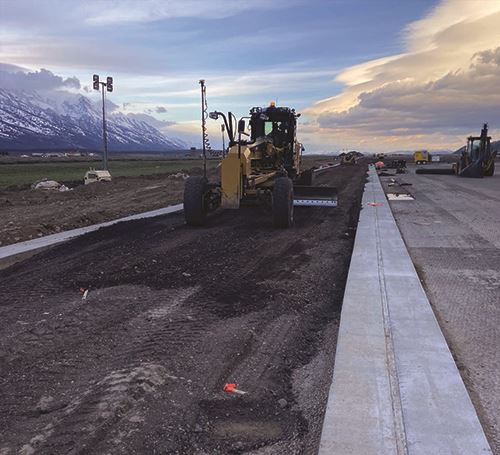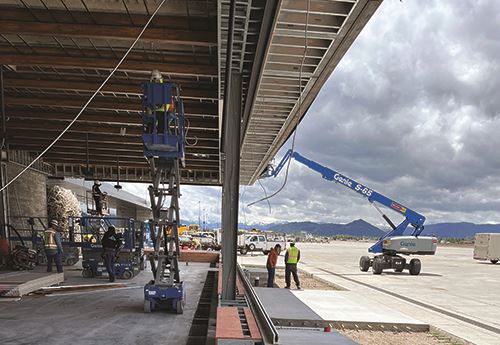Sooner or later, most single-runway airports have to bite the bullet and shut down to rehab their airstrip. For Jackson Hole Airport (JAC), that time came this spring. When the Wyoming airfield reopened in late June, it had a reconstructed runway designed to last for many decades and improvements in and around the terminal, to boot.
Sooner or later, most single-runway airports have to bite the bullet and shut down to rehab their airstrip. For Jackson Hole Airport (JAC), that time came this spring. When the Wyoming airfield reopened in late June, it had a reconstructed runway designed to last for many decades and improvements in and around the terminal, to boot.
 Executive Director Jim Elwood and his staff worked to accommodate airport stakeholders by compressing the construction schedule for the runway work as much as possible. Because the airport is located within Grand Teton National Park, the project team had to coordinate closely with the National Park Service and other stakeholders such as Wyoming Game and Fish, Wyoming Department of Environmental Quality and the Environmental Protection Agency. JAC has the unique distinction of being the only U.S. airport located inside a national park.
Executive Director Jim Elwood and his staff worked to accommodate airport stakeholders by compressing the construction schedule for the runway work as much as possible. Because the airport is located within Grand Teton National Park, the project team had to coordinate closely with the National Park Service and other stakeholders such as Wyoming Game and Fish, Wyoming Department of Environmental Quality and the Environmental Protection Agency. JAC has the unique distinction of being the only U.S. airport located inside a national park.
Elwood knew that JAC’s runway was on borrowed time because it hadn’t been fully rebuilt since the 1970s and was showing its age. In 2018, the airport hired Jviation as the engineer of record, and the firm helped determine exactly what needed to be done with the runway.
 Initially, it was believed that a simple rehabilitation project was all that was required to repair the runway, as was the case over the last 30 years. But the results of several geotechnical examinations changed people’s minds. “It would not be in the best interest of the airport or the FAA to invest $10 million for a temporary fix in a rehabilitation project at this time, based on the results of the latest geotechnical investigation. Therefore, we recommended a full reconstruction, which increased the cost to more than $40 million,” explains Stuart Schiff, project engineer and construction manager for Jviation.
Initially, it was believed that a simple rehabilitation project was all that was required to repair the runway, as was the case over the last 30 years. But the results of several geotechnical examinations changed people’s minds. “It would not be in the best interest of the airport or the FAA to invest $10 million for a temporary fix in a rehabilitation project at this time, based on the results of the latest geotechnical investigation. Therefore, we recommended a full reconstruction, which increased the cost to more than $40 million,” explains Stuart Schiff, project engineer and construction manager for Jviation.
Planning and Funding
 The preliminary on-site studies also helped the airport secure federal funding. “The FAA supported and even encouraged our geotech investigations,” states Paul Fiore, project manager for Jviation. “They wanted to know exactly what might be needed before approving funding. Along with the runway, we also investigated the taxiways as well, which helped all parties better understand the larger scope of the project.”
The preliminary on-site studies also helped the airport secure federal funding. “The FAA supported and even encouraged our geotech investigations,” states Paul Fiore, project manager for Jviation. “They wanted to know exactly what might be needed before approving funding. Along with the runway, we also investigated the taxiways as well, which helped all parties better understand the larger scope of the project.”
Staff at JAC worked closely with the Jackson Hole Airport Board to plan and prepare for additional projects while the airport would be shut down for this runway work. They included improving main connector taxiways (A1 and A4), parking lots and several areas in the terminal. “Jviation was a great partner in helping us create detailed plans that we could take to the FAA when we made our official funding request,” says Assistant Airport Director Dustin Havel. “They attended all of the meetings we had with the FAA and provided excellent input.”
 The engineering firm also helped prepare the bidding documents on behalf of the airport. These documents listed several conditions for bidders, including:
The engineering firm also helped prepare the bidding documents on behalf of the airport. These documents listed several conditions for bidders, including:
- Runway work had to be performed from early April through June 2022, when the airport would be less busy. A firm 78-day work schedule was imperative.
- At least 90% of the pavement section from the existing runway was to be recycled and reused in the subbase for the new pavement section.
- An improved stormwater drainage system was needed to accommodate the 150 to 175 inches of snow JAC receives each year.
- Strict environmental regulations had to be met.
- Work inside the terminal would be done while the airport was closed.
After reviewing several bids, the airport selected Knife River as the prime contractor for runway and taxiway reconstruction. Knife River, in turn, selected HD Fowler as the pipe supplier for the drainage project. Fowler hired Contech Engineering Solutions to supply the slot drains, and attach them to the pipes.
In addition, Wadman Corporation was awarded the contract for interior terminal improvements. Schiff and other representatives from Jviation remained on-site throughout construction.
Airport and Jviation officials developed a three-phase timeline for the project:
Phase One—July 6 to Oct. 15, 2021—included prep work, paving the extended runway safety areas, installing storm drainage trunk lines, screening and crushing on-site materials to produce aggregate base courses, and staging construction materials for Phase Two. The airport would remain open, and crews were expected to complete much of the work at night.
During Phase Two, the airport would close from April 11 to June 27, 2022, for reconstruction of the main runway (1-19) and taxiways A1 and A4. This phase, the bulk of the work, would be a 24/7 operation.
Phase Three would primarily include runway grooving and final permanent striping.
Communication Strategies
With contractors selected and a firm schedule in place, airport officials began telling stakeholders specifically what work was going to be done, and when.
The four commercial airlines that serve JAC (United, American, Delta and Alaska) were given at least one year advance notice about the runway work and an associated closure. This allowed them to adjust flight schedules into/out of nearby airports in Idaho Falls, ID; Casper, WY; and Bozeman, MT. The airport also notified several general aviation airports in the area that they might be getting more business from general aviation pilots based at JAC.
On-site rental car companies at JAC were given the option of staying open. Instead of paying their standard fixed rent to the airport, rental car operators and the restaurant paid a percentage of gross receipts during the 78-day closure. Concessionaires that closed temporarily were given rent abatements.
 Several months before construction began, senior staff, including Elwood, gave informational presentations to local organizations and homeowners. “Meeting with our close neighbors was especially important to convey construction schedules and set realistic expectations during the project phases,” says Megan Jenkins, the airport’s communications manager. “Neighbors were given a direct point of contact for questions. The airport also created a projects page on its website that included timelines, work schedules and other related news.”
Several months before construction began, senior staff, including Elwood, gave informational presentations to local organizations and homeowners. “Meeting with our close neighbors was especially important to convey construction schedules and set realistic expectations during the project phases,” says Megan Jenkins, the airport’s communications manager. “Neighbors were given a direct point of contact for questions. The airport also created a projects page on its website that included timelines, work schedules and other related news.”
Throughout construction, the airport communications team worked with Jviation and local communications firms to produce a social media campaign, a video blog series, and a radio show called the Airport Report to keep the community up to date on progress and share environmental measures about the project.
|
facts&figures Project: Runway Reconstruction Location: Jackson Hole (WY) Airport 2019 Operations: 27,000 Commercial Airlines: Alaska; American; Delta; United Project Cost: $43.8 million Runway Funding: FAA; airport improvement funds Prep Work, Drainage Improvements & Paving Extended Runway Safety Area: July 6 to Oct. 15, 2021 Runway Reconstruction: April 11 to June 27, 2022 Grooving & Striping: Aug. through early Sept., 2022 Engineer of Record/Consultant: Jviation Prime Construction Contractor: Knife River Storm Drainage System: Contech Pipe Supplier: HD Fowler Electrical Contractor: Royal Electric Milling Subcontractor: Porter W. Yett Quality Assurance: STRATA Quality Control: Solterra Engineering Surveyors: Nelson Engineering Terminal Improvements: $31 million Funding: 65% federal, 34% local, 1% state Project Manager: KLJ Architect: Jviation/CLB General Contractor: Wadman Benefits: Reconstructed runway was designed to last several decades; airport improved terminal while closed for runway work |
In addition, the local Chamber of Commerce partnered with JAC to help deliver its message to travelers, business owners and community members.
Airport officials also had several meetings with colleagues at Idaho Falls Regional Airport (IDA) to help them prepare for the upcoming closure at JAC. “They coordinated with their rental car agencies to have increased inventory to accommodate more reservations and also added more long-term parking,” Elwood notes.
Jackson Hole residents accustomed to flying out of JAC had a two-hour drive to IDA, without weather delays.
During and after the project was complete, Elwood thanked stakeholders for their patience during the airfield closure.
Adjusting Between Phases
Chris Boniface, project manager for Knife River, reports that the first phase went smoothly and proved to be invaluable for planning Phase Two, when the runway would close the following spring.
“I spent the winter of 2021-2022 reviewing all details in the engineering plan and construction documents, ensuring that the proper materials were submitted/approved and procured ahead of the full closure,” Boniface recalls. “Every detail was carefully scrutinized.”
He also worked to clarify specific details about the project, knowing there would be no time to wait for answers from engineers or FAA personnel during the 78-day closure. “Jviation was a true partner on working through these items ahead of time,” Boniface remarks.
In fall 2021, after Phase One was complete, Boniface developed a comprehensive schedule for the 78-day timetable. The detailed plan was broken down between day and night shifts (12-hour blocks) and each activity by the hour. Every crew and the equipment they would use were identified to ensure appropriate resources were ready.
In the months leading up Phase Two, Boniface worked with Jviation and project subcontractors to review and modify the resource-loaded Critical Path Method schedule until he was satisfied that the team was properly prepared for the daily workload. The schedule was intentionally front-loaded, to provide additional float time for near-critical activities. This proved to be absolutely critical as Jackson Hole experienced some of its worst spring weather on record.
During Phase One, Knife River had worked with its quality control staff and Jviation to excavate seven test pits, which allowed them to engineer a mix design in advance. “Being that a mix design for FDR (full-depth reclamation) can take more than three weeks to complete, this was an integral part of our ability to be complete on time during Phase Two,” explains Boniface.
Knife River mobilized about 120 pieces of equipment during the first phase. Some pieces, such as a large bucket loader, haul trucks and mobile asphalt and concrete plants, required special permits and police escorts to travel through the city to the airport.

To kick off the reconstruction, subcontractor Porter W. Yett roto-milled the existing runway and repurposed it as full-depth reclamation material to be used in the structural section for the new runway. Knife River used seven haul trucks to temporarily stockpile the material next to the runway.
Crews installed a layer of the repurposed material, which was then chemically treated with asphalt and cement in place by a pulverizer to provide the structural characteristics required by the project contract.
 Unfortunately, workers had to contend with one of the snowiest, wettest and coldest springs on record for Jackson Hole. “We really put our heads down and just worked through it,” Boniface recalls.
Unfortunately, workers had to contend with one of the snowiest, wettest and coldest springs on record for Jackson Hole. “We really put our heads down and just worked through it,” Boniface recalls.
He also adjusted the schedule so crews could accomplish other tasks while delaying elements that required better weather. For instance, when roto-milling the existing runway, contractors left certain layers in place while removing other layers to channel the snow and/or rainwater to less critical areas. Boniface compares the process of removing the existing runway to peeling an onion, one layer at a time.
Crews used concrete blankets and heaters (ground and forced air) to protect the concrete and keep it at the proper temperature during pouring and curing.
When the bad weather finally ended, Knife River caught up and met its crucial deadline before the runway had to reopen.
On average, there were 115 employees from Knife River on site daily, plus additional subcontractors. Because most workers were from Idaho Falls, where Knife River is based, the company secured hotel rooms and campsites for employees and issued per diem payments to help cover expenses associated with working out of town. The project team even arranged for an airport restaurant to set up a food truck that served workers breakfast, lunch and dinner.
Runway grooving and final permanent striping began in August 2022 and was completed in early September.

Custom Drains
A specially made slotted drain system is one of the new runway’s standout components. In short, the airport wanted high-performance drains that would capture pavement surface runoff along the runway, and send it to an airport detention and filtration system. The drains also had to stand up to snow removal equipment in the winter.
The project team selected a Contech system with polymer-coated steel pipes because it met JAC’s hydraulic, structural and durability needs. Bob Moore, region engineer for Contech, notes that piping for the system had to be highly durable to withstand the rough climate in Jackson Hole. “It also is composed of 95% recycled steel, which pleased airport officials who wanted to be as environmentally responsible as possible,” he adds, noting that the pipe is designed to last 100 years.
Before beginning production, Contech wanted to make sure that everyone agreed about the composition. Representatives from Jviation and Knife River traveled to the company’s factory in Mitchell, IN, to oversee design and construction, as well as Contech’s quality control program. The on-site project reps agreed to the construction standards, but still wanted to test a sample of the new system at the airport before giving Contech the green light to produce and ship the 29,000 feet of piping needed for the project.
The company consequently produced a test strip about 2,000 feet long, and asked Jviation and Knife River personnel for input when they came to tour the company’s plant. The project reps suggested a few minor tweaks about the connecting bands and requested shorter pieces of pipe for the project. Contech incorporated these suggestions and shipped the sample pipe to the airport.
As planned, Knife River installed the test pipe at JAC in fall 2021. That winter, airport staff plowed snow near the sample piece, and project managers agreed that the pipe worked as promised.
Contech promptly ramped up production and shipped the large run of pipes to the airport in early 2022.
To install the pipes, crews from Knife River dug tilted trenches that were 2 feet deep and 3 feet wide, then centered pieces of pipe inside. The slotted drains had been welded into the pipes at the factory.

Runoff from rooftops, the runway and other hard surfaces throughout the airfield runs into two large retainer ponds. There, a sand filtration system removes oil, sediment and other material before the cleaned water is pumped to the surface and discharged as surface water.
It was vital to the Jackson Hole Airport Board, airport staff, the National Park Service and other agencies that any pollutants from the runway drains would not reach the Snake River and its tributaries. The airport itself sits about 50 feet over a large aquifer that drains into the river. “We are pleased that our drainage system, along with the existing detention and filtration system in place, helps keeps that river as clean as possible,” says Rob Chapman, director of products and analytics for Contech.
Terminal Renovations, Too
Since the airport was closing from early April through most of June 2022, airport officials scheduled terminal renovations at the same time.
Work there included selective demolition, renovation and expansion to create two new gates; an improved holdroom; a larger restaurant with a full basement for storage, offices and training rooms; two new ticket counters; and an expanded TSA checkpoint with four lanes rather than three. (If necessary, there is room to add two more TSA lanes in the future.) In addition, crew performed pavement maintenance on the terminal parking areas and installed new fencing.
The TSA checkpoint was renovated and expanded from three lanes to four. In addition, pavement maintenance was conducted on the terminal parking areas, and new fencing was installed.
Several other projects were completed up to a year before the TSA checkpoint area was renovated. This work made it easier for airport and airline personnel to be moved efficiently while the upgrades were made.
 One of the biggest challenges for Wadman, the general contractor, was working within the existing footprint. “Dating back several decades, there was an agreement with Grand Teton National Park to keep the airport its current size,” says Tyler Shupe, a company superintendent. “Nevertheless, we were able to remodel space, add new electrical systems and make other improvements.”
One of the biggest challenges for Wadman, the general contractor, was working within the existing footprint. “Dating back several decades, there was an agreement with Grand Teton National Park to keep the airport its current size,” says Tyler Shupe, a company superintendent. “Nevertheless, we were able to remodel space, add new electrical systems and make other improvements.”
Shupe predicts that passengers will really like the new renovations. The new restaurant complex will include table service, grab-and-go options and a bar. “It will have great floor-to-ceiling windows, facing west and northwest, with great views of the mountains. It also will tie back into the renovations and designs made over the last few years,” he remarks.
A full basement under the new restaurant will provide additional storage. Construction of this section is expected to be complete by the end of this year. In the meantime, the airport continues to offer limited food and beverage options post-security throughout.
All’s Well
Since the airport reopened in late June, Elwood has received extensive compliments about the runway and spruced-up terminal.
“I believe the planning and close cooperation between our airport and all of our partners made a huge difference,” he says. “We could not have accomplished this project in only 78 days without that dedication.”



